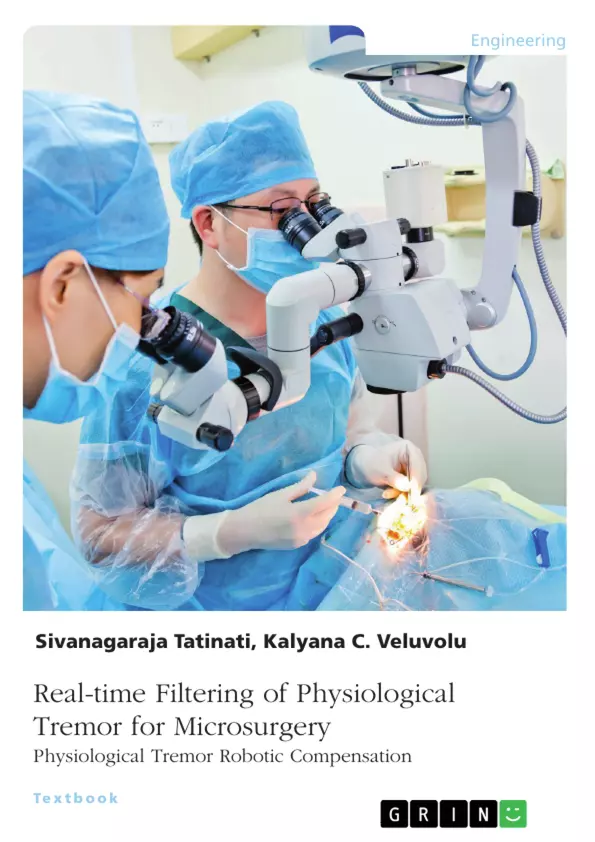The work conducted in this dissertation focuses on issues that are related to the accurate and real-time separation of physiological tremor components from the sensed motion. This dissertation mainly focused on developing new algorithms and techniques for accurate modeling and prediction of physiological tremor components ( the filtering and modeling system) for the hand-held instruments. The methods developed in the course of this dissertation were validated with the physiological tremor database collected from micro-surgeons and novice subjects. Further, the methods were experimentally validated with the bench tests conducted on hand-held instrument, iTrem.
Precision, robustness, dexterity, and intelligence are the design indices for current generation surgical robotics. In microsurgeries, physiological tremor – an intrinsic hand motion with amplitude of 100µm – is a major impediment for surgeons’ to perform delicate and fine motor tasks in sub-millimeter space. To augment the required precision and dexterity into normal microsurgical workflow by compensating the tremor in real-time, hand-held robotic instruments are developed. The working principle of a typical handheld instrument involves subsequent execution of three steps 1) sensing its own motion with inertial sensors, 2) filtering the involuntary motion from the sensed motion, and 3) actuate the surgical end-effectors (instrument tip) based on the filtered involuntary motions to compensate the tremor motion.
Generally, digital filters are employed to filter out the noise components and subsequently extract the tremor motion from the whole motion. As a result, a time-varying and unknown delay in the range of 20 to 200ms (depends on the variant of the filter) is introduced into the tremor compensation proceedings, which in turn, adversely affects the tremor compensation performance. Ideally, zero phase lag between the actual tremor and extracted tremor motion is essential for hand-held instruments. This motivates development of new and innovative signal processing solutions, which can enhance the performance of hand-held instruments, in practice. We believe the key to achieve this goal is to go beyond the paradigm of conventional linear modelling techniques, which is limited to least squares solutions. This book proposes several solutions to overcome the existing issues and propose new solutions based on machine learning techniques for correction of phase delay.
Inhaltsverzeichnis (Table of Contents)
- Summary
- Chapter 1: Introduction to Microsurgery and Physiological Tremor
- 1.1 Challenges in Microsurgery
- 1.2 Physiological Tremor: An Impediment
- 1.3 Existing Solutions and Their Limitations
- Chapter 2: Handheld Robotic Instruments for Tremor Compensation
- 2.1 Working Principle and Components
- 2.2 The Role of Digital Filters
- 2.3 Limitations of Conventional Filtering Techniques
- Chapter 3: Proposed Solutions Using Machine Learning Techniques
- 3.1 Novel Signal Processing Approaches
- 3.2 Addressing Phase Delay Issues
- 3.3 Machine Learning Algorithms for Tremor Compensation
Zielsetzung und Themenschwerpunkte (Objectives and Key Themes)
This book aims to improve the precision and dexterity of handheld robotic instruments used in microsurgery by developing innovative signal processing solutions to address the phase delay issues inherent in current tremor compensation methods. It explores the limitations of existing linear modeling techniques and proposes solutions based on machine learning.
- Compensation of physiological tremor in real-time microsurgery.
- Limitations of conventional digital filtering techniques in tremor compensation.
- Application of machine learning for improved phase delay correction.
- Development of novel signal processing solutions for handheld robotic instruments.
- Enhanced precision and dexterity in microsurgical procedures.
Zusammenfassung der Kapitel (Chapter Summaries)
Chapter 1: This chapter introduces the challenges in microsurgery, focusing on the impact of physiological tremor on the precision of delicate procedures. It discusses existing solutions and highlights their limitations, primarily concerning the time delay introduced by digital filtering.
Chapter 2: This chapter details the functioning of handheld robotic instruments used for tremor compensation. It explains the process of sensing, filtering, and actuating the surgical instrument, emphasizing the role and drawbacks of digital filters in this process.
Chapter 3: This chapter presents the core contribution of the book: novel solutions based on machine learning techniques for improved tremor compensation. It outlines the proposed algorithms and their advantages in addressing the limitations of conventional methods.
Schlüsselwörter (Keywords)
Microsurgery, physiological tremor, tremor compensation, handheld robotic instruments, digital filters, phase delay, machine learning, signal processing, precision, dexterity.
- Quote paper
- Kalyana Veluvolu (Author), Sivanagaraja Tatinati (Author), 2020, Real-time Filtering of Physiological Tremor for Microsurgery. Physiological Tremor Robotic Compensation, Munich, GRIN Verlag, https://www.grin.com/document/948843



